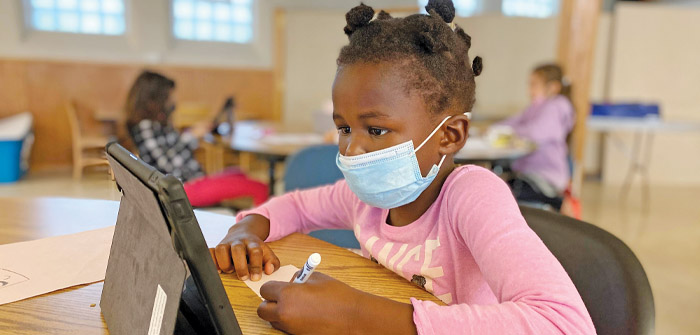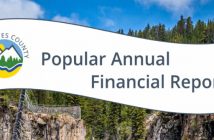(Boys & Girls Clubs of Bend now offers full-day programming in response to Bend-La Pine Schools’ current Distance Learning model | Photo courtesy of Boys & Girls Clubs of Bend)
In a world gone awry, there is no shortage of people who need help. Men, women and children of all ages and backgrounds need assistance now more than ever before. However, the organizations that step up to help others are having their own struggles in the midst of 2020’s plights. Over the past eight months, nonprofit agencies have been forced to pivot the way they function and the way in which they generate funding. We at Cascade Business News checked in with a handful of nonprofits in Central Oregon to see how they are faring, and what they anticipate moving into the next season. Thankfully, it’s not all bad news: Despite the challenges, these stellar groups have found ways to thrive — from creative operational changes and online fundraising to expansion through the use of technology, all with a renewed spirit of collaboration.
“We’re going a mile a minute,” says Ken Wilhelm, executive director of United Way of Central Oregon, (unitedwaycentraloregon.org). “This would be a busy time under normal circumstances as we enter our main fundraising season. Now, we’re also reviewing proposals and distributing grants, as well as coordinating with other organizations in responding to urgent community problems as they crop up.” United Way, which works to strengthen communities in Crook, Deschutes and Jefferson Counties by investing locally in needed programs and services, partners with a variety of nonprofits in the region. “I’ve been impressed with how many organizations have risen to the challenge of the time by adapting how they do business and deliver their services,” says Wilhelm. “They are all going a mile a minute, too, putting in extra hours. But I think the agencies have been remarkably creative in dealing with this.”
Maggie Wells, Program Manager of the LOFT, which houses homeless and runaway youth and is a program of Cascade Youth and Family Center (cascadeyouthandfamilycenter.org), agrees that COVID has altered the way the organization operates, describing daily life as “hectic” at the LOFT. “It’s structured chaos most days, to say the least,” she says with a laugh.
“This year has put everyone to the test,” says Gwenn Wysling, executive director of Bethlehem Inn (bethleheminn.org). “Fortunately, with the support of an amazing community and decades of experience as an emergency shelter, we are skilled at pivoting to meet the challenges of a changing environment.”
Juliana Williams, executive director of the Boys & Girls Clubs of Bend (bgcbend.org), said her organization has shifted significantly since COVID began. “We’ve gone through different phases of operations and how we are responding,” she says. “We’ve been able to really capitalize on our strengths, taking what we do best and the strengths we have and expanding upon those to meet the gap that families are facing right now.”
Williams says that the families they serve are in even greater need now because of the virtual schooling situation, so the Clubs pivoted from being an after-school and break-time program to a full-day program for school-aged youth. “This has happened in a couple of ways,” she explains. “First, in increased health and safety protocols to make sure youth, staff and families stay healthy during the time of this pandemic, and through the expansion of programming. We were early in terms of planning for full days for the school year; we were anticipating that this was the likely scenario, so we were really ready with our plans, which enabled us to focus on key funding opportunities. Several of those that we have received have been specifically aimed at prioritizing spots for families who need financial support to access our services; we’ve been able to offer scholarships to nearly 90 percent of our families.”
“Initially, when things got shut down, we went from a pretty robust schedule with families, children and our community partners like law enforcement, child protect services and DHS to things really slowing down,” says Gil Levy, executive director of KIDS Center (kidscenter.org), a child abuse intervention center. “But since then, we have put lots of safety protocols in place. We are not up at the same level as in a normal year, but we are getting much closer to that now.” For KIDS Center, as a child advocacy center serving Central Oregon, Levy says the process of working with a child who may have experienced abuse is very involved. “We provide a medical exam and a forensic interview so they can tell their story, give access to therapy, provide emotional support and see the family through the whole process. The day a child comes to be examined and tell their story is an intense experience; we are able to provide that again now, just with a lot of safety protocols in place.”
At Big Brothers Big Sisters of Central Oregon (bbbsco.org), Bridget Albert, community outreach coordinator, says that when the county shut down, they were unable to make matches between the adult volunteers (“Bigs”) and the recipient children (“Littles”), so they quickly pivoted their focus from providing mentors to providing basic needs to the families, who often face barriers in acquiring these needs. “Eighty percent of our Littles come from low-income households, 60 percent are from single-parent families and 30 percent of our Littles are People of Color who have been disproportionately affected by the economic, health and social impact of this pandemic,” says Albert. “After surveying our families, we discovered that more than 50 percent of the parents/guardians of our Littles either lost their job, were laid off or had a reduction in hours. Forty percent of our families experienced food insecurity and 45 percent needed help paying utilities.” She adds, “Many of these families feel uncomfortable seeking help elsewhere due to immigration status and discrimination, so with the support of our community, BBBSCO jumped into action.”
Eric Alexander, CEO of Partners In Care hospice (partnersbend.org), says that during the pandemic, the care and safety of patients, their family caregivers and the Partners In Care staff has been top priority. “Because elderly and immune-compromised patients account for a large part of Partners In Care’s patients, stringent protocols were instituted from the beginning. Protocols include a minimal visit plan based on patient needs, supplemented with virtual visits and the use of monitoring technology; use of disposable items and personal protective equipment; continued sanitation; and daily monitoring of staff wellness.” At Partners In Care’s in-patient Hospice House in Bend, all visitors are carefully screened prior to visiting patients. Screening includes specific questions, sanitizing and taking the temperature of each visitor.
Despite the pandemic, Alexander says the average daily census for all service lines at Partners In Care has remained at or above the target goal throughout 2020. “Partners In Care is a robust and successful organization with strong, resourceful and resilient teams and individuals who have consistently demonstrated an ability to navigate through difficult situations in order to act from a place of compassion.”
Arlene Gibson, co-founder and president of Younity (younityus.org), which provides bully prevention programs and workshops in Central Oregon, says she believes the events of 2020 have made Younity’s programs more relevant than ever before because there is a current surge in bullying. “Since COVID began, we have been unable to deliver our programs directly to the community and local schools, which is what we’ve done since 2009,” she says. “But now we have virtual interactive programs as our delivery method via several platforms. That’s a huge change. It’s working out; we are doing well.”




